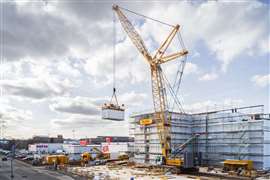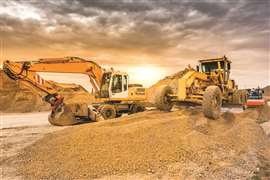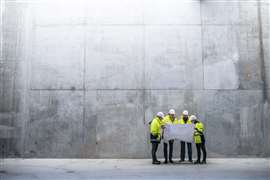Read this article in Français Deutsch Italiano Português Español
5 ways formwork and falsework are evolving
27 October 2025
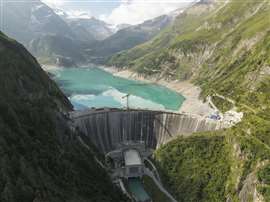 (Image courtesy of Doka)
(Image courtesy of Doka)
At first glance, formwork and falsework seems a simple-enough concept, vital though it is for temporary works.
But in fact, innovation is being applied to the sector constantly. Formwork and falsework are evolving rapidly, incorporating advanced digital technology and becoming more adaptable, flexible, and efficient.
Construction’s familiar challenges – cost pressure, labour shortages, and rising complexity are what’s helping to drive innovation, with the ongoing expectation to be able to do more with less.
As contractors take on larger, more technically demanding builds, from supertall towers to remote civil works, temporary works are becoming smarter, lighter, and more adaptable.
Here are five ways formwork and falsework are evolving:
1) Lightweight and modular systems are the new standard
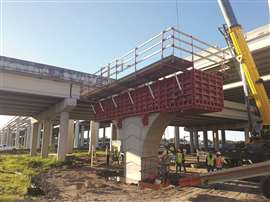 Alsina’s Self-Spanning Formwork System deployed at the Golden Glades Interchange in Florida, US. Image: Alsina
Alsina’s Self-Spanning Formwork System deployed at the Golden Glades Interchange in Florida, US. Image: Alsina
Contractors are demanding equipment that saves time and labour. Modular, crane-free systems are rapidly replacing heavier, traditional setups.
Alsina’s Self-Spanning System, used on Florida’s Golden Glades Interchange project, adapts to varied geometries with the same panels, cutting material shipments by 30%.
Meanwhile, Doka’s DokaFit range, developed in Asia and now used across the Middle East, aims to reduce crew size and cycle times without sacrificing concrete finish quality. DokaFit Handset uses lightweight, modular panels for walls, columns, and foundations, designed for crane-free handling. DokaFit Prop, is an adjustable support with ergonomic fastenings for slab work. Doka executive vice president of the Americas, Michael Kennedy, says Doka’s Fit line is “jobsite ready”. The system’s key value lies in its speed and reusability, with panels that can be locked and unlocked by hand, repositioned without a crane, and reused across different site conditions.
2) Digitalisation is reshaping design and delivery
Formwork processes have tended to be bulky, fragmented, and labour-intensive to install and remove. But manufacturers are introducing connected platforms to streamline planning, ordering, and on-site coordination.
At Bauma 2025, Doka introduced its Doka 360 platform, which links every step from design to returns, replacing manual coordination with centralised workflows.
For its part, Alsina’s digital strategy extends to AI and automation, with tools like MyAlsina for project management, aCeler for automatic formwork design, and Metalearning for interactive worker training. The company is also testing embedded sensors that track pressure, temperature, and formwork reuse across sites, improving efficiency and safety.
3) Sustainability is driving innovation
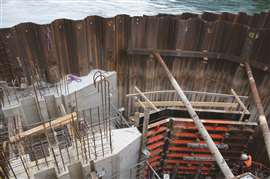 Paschal formwork in use on a fish ladder construction project in southern Germany. Image: Paschal
Paschal formwork in use on a fish ladder construction project in southern Germany. Image: Paschal
With environmental targets tightening, formwork manufacturers are aligning with circular economy principles.
Alsina’s rental-based business model reduces the need for new production by up to 70%, while its lightweight, reusable panels extend product life.
In Alsace, France, German firm Paschal’s formwork has helped salmon to migrate through the Upper Rhine river, as part of the construction of a one-kilometre-long fish ladder at an EDF hydropower plant near Marckolsheim.
Paschal’s role includes forming round walls, supporting high single-sided formwork up to 8m and making complex adjustments to existing structures. The company had deployed its variable radius circular trapezoidal girder formwork, pre-rounded in the factory for immediate use on site, as well as LOGO.3 wall formwork to handle long and high walls without the need for costly on-site shuttering.
4) Complex structures demand adaptable systems
As buildings and infrastructure grow more complex, so does the need for flexible, high-performance temporary works.
Germany-based formwork company Peri’s systems have supported some of the world’s most challenging builds. In Vienna, Austria, its 180m DC Tower 2, where its RCS Max Rail Climbing System and Maximo formwork enabled more than 80 concrete fours, and a five-day rhythm per cycle.
In Chile, Peri has supplied formwork and scaffolding for the foundation, central base, and wall structures for the challenging construction of the Extremely Large Telescope, where work is taking place at 3,046 metres above sea level. Peri provided Trio panel formwork for heavy concrete walls and ST 100 stacking towers for cantilevered platform support. A flexible Multiflex slab system was used for the telescope’s circular base to handle challenging geometry. Peri also provided engineering and logistical support to minimise delays and meet demanding load and assembly requirements.
And in Norway, RMD Kwikform’s Rapidshor system has also proven its adaptability, supporting the Saggrenda Bridge in Norway’s steep valleys. Working with Maxbo Teknikk, RMD designed a temporary works solution to handle narrow widths, post-tensioning loads, and deep-valley topography for the 310-metre concrete arch project in Kongsberg.
5) Regional markets are shaping product strategies
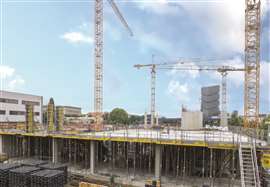
Manufacturers are tailoring innovation to regional growth patterns. Doka sees rapid adoption in Asia, particularly India, where urbanisation and technology uptake are accelerating demand. In North America, strong data centre activity, as well as residential demand, is pushing interest in lightweight aluminium systems once confined to Asia. “We’re seeing ideas migrate,” Kennedy says. “Lightweight aluminium systems that made sense in Asia are now proving relevant here in North America, especially as labour gets tighter and schedules get shorter.”
Alsina reports strong growth in Southeast Asia, Europe, North Africa, and the US, adapting designs to local labour and logistical conditions. “Each market requires different types of formwork systems,” says Alsina’s Jimy Peñailillo. “Alsina’s strength lies in its ability to adapt to the specific needs of each client, in every market.”
The direction of travel is clear: temporary works are becoming more digital, data-driven, and sustainable, with reuse and modularity central to design.
With innovations heightening the value of circular models and digital training, the future of formwork is no longer just about supporting the build; it’s about supporting smarter, efficient construction across the industry.
STAY CONNECTED


Receive the information you need when you need it through our world-leading magazines, newsletters and daily briefings.
CONNECT WITH THE TEAM









